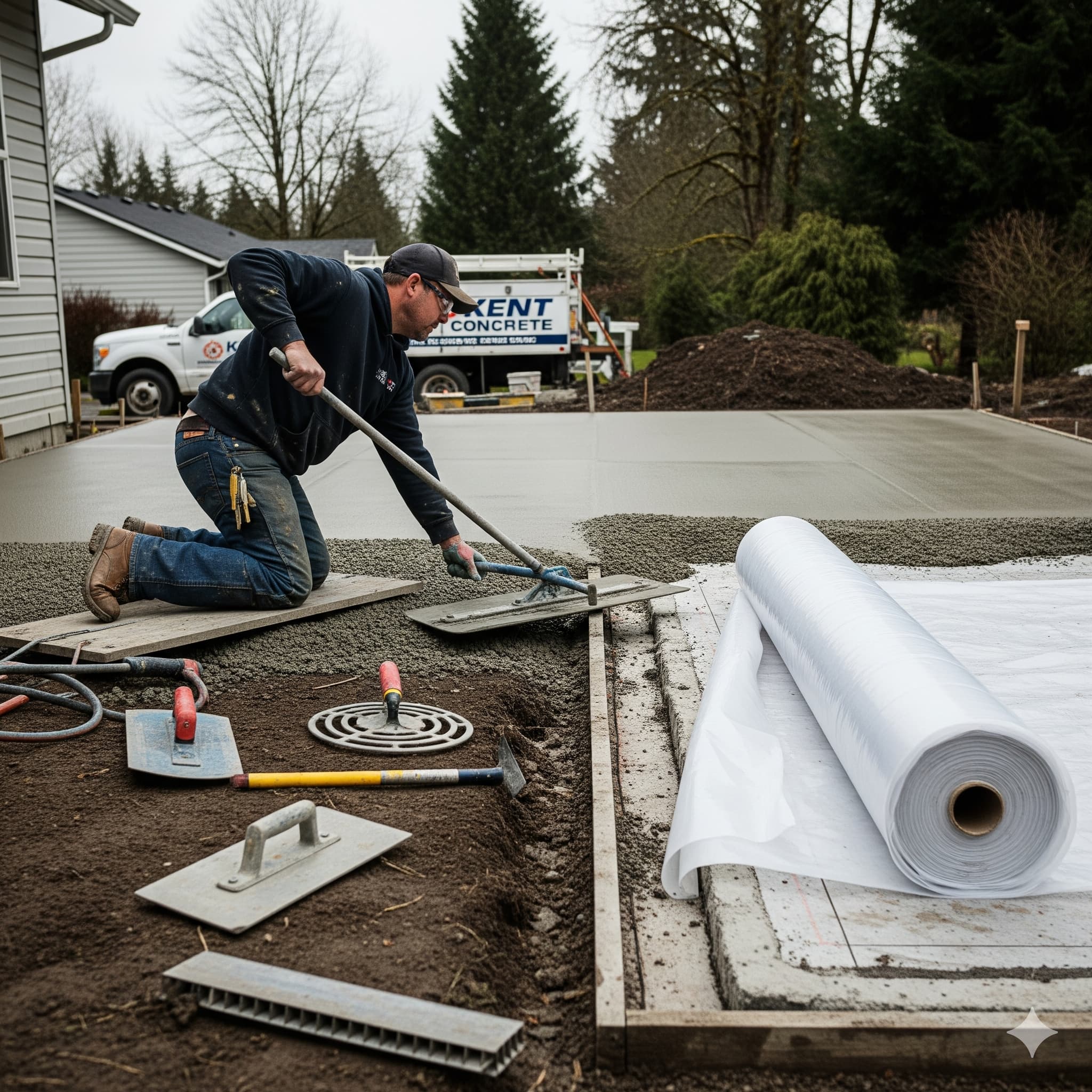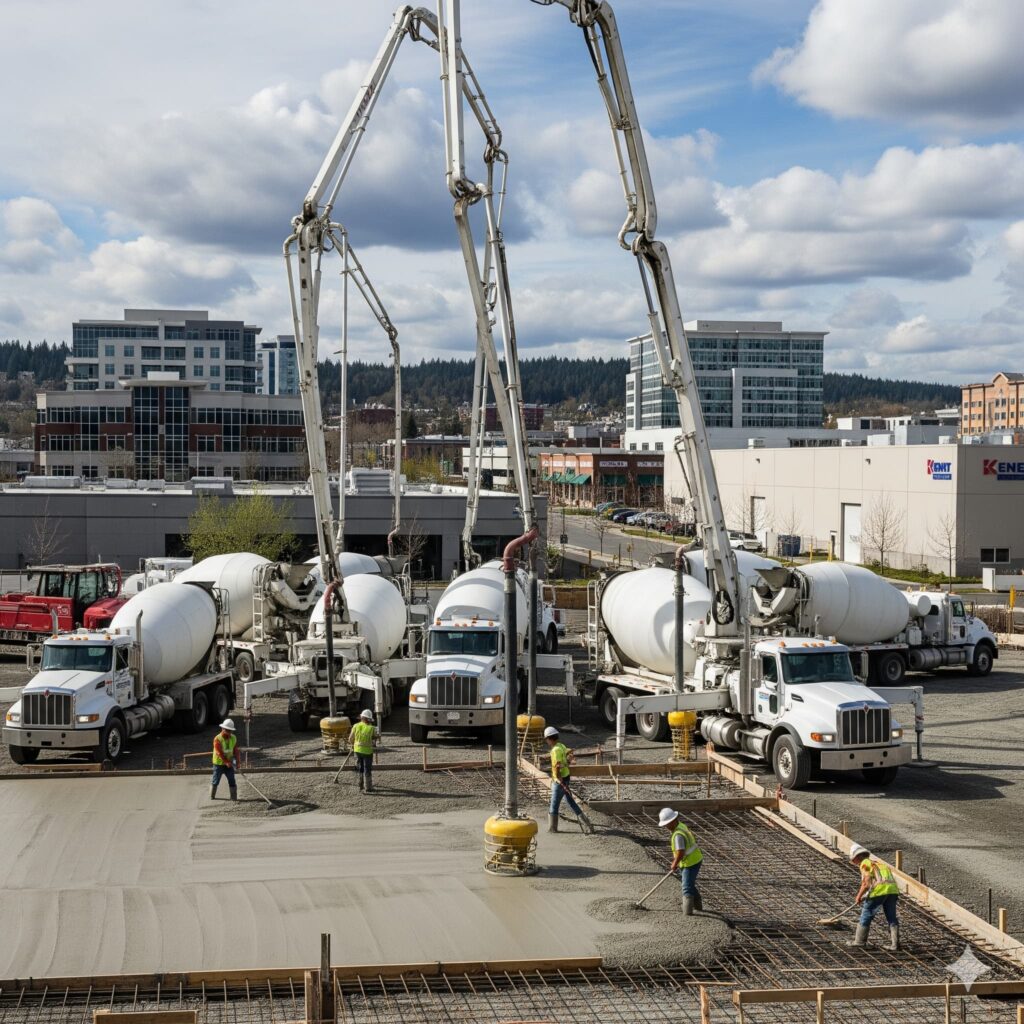
Commercial Concrete in Kent: Expectations vs. Reality
Commercial concrete projects in Kent present unique challenges and opportunities that differ significantly from residential work. Understanding the realities of large-scale concrete operations helps business owners, developers, and project managers make informed decisions while setting realistic expectations for timeline, costs, and coordination requirements in the Pacific Northwest’s demanding construction environment.

Scale and Complexity Differences
Commercial concrete projects typically involve substantially larger volumes and more complex logistics than most business owners anticipate. A typical warehouse floor might require 200 to 500 cubic yards of concrete compared to 3 to 5 cubic yards for a residential driveway, creating coordination challenges that affect scheduling, traffic management, and site logistics.
The expectation of simple, straightforward pours often conflicts with the reality of coordinating multiple concrete trucks, pumping equipment, finishing crews, and inspection requirements. Commercial projects near Kent’s industrial areas, like the Boeing facilities or along Highway 16,7 require additional coordination with traffic management and utility companies.
Project complexity increases exponentially with size due to structural requirements, reinforcement placement, and quality control procedures that residential projects rarely encounter. Commercial specifications often require specific concrete mixes, testing protocols, and documentation that add time and complexity to seemingly straightforward operations.
Weather dependencies become more critical with larger projects because delays affect multiple crews, equipment rentals, and supplier schedules. Kent’s unpredictable weather patterns can cascade minor delays into significant scheduling and cost impacts for commercial concrete operations.
Timeline and Scheduling Realities
Business owners often expect commercial concrete pours to proceed quickly once started, but reality includes substantial preparation time for site work, permits, and coordination activities. Pre-pour activities typically require 2 to 4 weeks for commercial projects compared to days for residential work.
The expectation of continuous concrete placement conflicts with practical limitatio,ns including truck delivery intervals, placement rates, and crew capacity. Large commercial pours often require 8 to 12 hours of continuous operation with multiple crew rotations to maintain quality and productivity.
Curing time requirements remain the same regardless of project size, meaning commercial slabs require 24 to 48 hours before foot traffic and 7 to 28 days before full loading. Business owners expecting immediate use often face disappointment when operations must wait for proper concrete strength development.
Seasonal scheduling in Kent becomes more complex for commercial projects due to extended timelines and weather exposure. Projects starting the in fall may face winter weather challenges that residential jobs can more easily avoid through flexible timing.
Cost Structure Variations
Expectations of linear cost scaling often prove unrealistic as commercial projects involve fixed costs for equipment, permits, and coordination that don’t scale proportionally with volume. Mobilization costs for pumping equipment and crews represent significant portions of smaller commercial projects.
Material costs benefit from volume purchasing but include additional expenses for quality control testing, specialized mixes, and performance requirements that residential projects rarely require. Commercial concrete specifications often cost 20 to 40 percent more per cubic yard due to these enhanced requirements.
Labor costs reflect skilled crew requirements and extended work periods that commercial projects demand. Finishing large commercial slabs requires specialized equipment and experienced operators who command premium rates compared to residential concrete work.
Hidden costs often emerge from permit fees, inspection requirements, traffic control, and utility coordination that business owners don’t anticipate. Kent’s commercial permitting process includes reviews and fees that can add substantial costs to project budgets.
Quality Control and Testing Requirements
Commercial projects require extensive testing and documentation that residential work rarely encounters. Concrete strength testing, slump tests, and air content measurements occur throughout placement operations, adding time and cost while ensuring specification compliance.
Quality expectations for commercial work often exceed what business owners anticipate, particularly for visible areas or specialized applications. Commercial standards require consistent appearance, precise elevation control, and durability performance that demands specialized techniques and equipment.
Inspection requirements by city officials, structural engineers, and quality control personnel can slow progress and require coordination that residential projects avoid. Kent’s commercial inspection process includes multiple checkpoints that must be scheduled and coordinated with concrete operations.
Documentation requirements for commercial projects include detailed records of materials, test results, and installation procedures that support warranty claims and future maintenance planning. This paperwork often surprises business owners expecting simple completion certificates.
Logistics and Site Coordination
Business owners often underestimate the site disruption and coordination challenges that commercial concrete projects create. Large trucks, pumping equipment, and crews require substantial space and access that may conflict with ongoing business operations.
Traffic management becomes essential for commercial projects, particularly those near Kent’s busy corridors like West Valley Highway or areas around ShoWare Center. Coordination with local authorities ensures compliance while minimizing disruption to surrounding businesses.
Utility coordination proves more complex for commercial projects due to underground services, overhead restrictions, and access requirements that residential properties rarely encounter. Pre-construction utility location and coordination often reveal conflicts requiring design modifications.
Storage and staging requirements for materials, equipment, and crews often exceed available space at commercial sites. Successful projects require careful planning for concrete trucks, reinforcement materials, and crew facilities without disrupting business operations.
Weather and Environmental Factors
Kent’s climate creates specific challenges for commercial concrete projects that affect both scheduling and performance. Large exposed areas are more vulnerable to rain damage, and extended placement times increase weather exposure risks compared to quick residential pours.
Temperature control becomes critical for large commercial placements where concrete temperature affects setting times and final strength. Hot weather installations may require ice, cooling systems, or admixtures that add complexity and cost to commercial operations.
Wind exposure on large commercial sites can accelerate surface drying and complicate finishing operations. Projects in Kent’s open industrial areas often require wind protection measures that residential projects rarely need.
Environmental compliance requirements for commercial projects include storm water management, dust control, and noise restrictions that affect operations and may require special procedures or equipment.
Equipment and Technology Requirements
Commercial concrete placement often requires specialized equipment, including concrete pumps, laser screeds, and power trowels that residential contractors may not typically use. These tools enable quality results on large projects but require experienced operators and significant investment.
Pumping equipment becomes essential for most commercial projects due to access limitations and placement volumes. Concrete pumps add costs but enable placement in areas inaccessible to trucks while maintaining consistent concrete quality throughout large pours.
Finishing equipment for commercial projects includes ride-on trowels, laser screeds, and surface preparation tools that ensure consistent results across large areas. Professional commercial contractors invest in equipment that enables efficient, high-quality work on substantial projects.
Testing equipment and quality control tools provide real-time feedback on concrete properties and placement quality. Commercial projects benefit from technology that ensures specification compliance while optimizing placement procedures.
Professional Expertise Requirements
Kent Concrete Masters brings specialized knowledge of commercial concrete requirement,s including local permitting, inspection procedures, and coordination protocols that ensure project success. Commercial expertise prevents costly mistakes while optimizing project efficiency.
Crew coordination and project management become critical for commercial success where multiple trades, inspections, and operational requirements intersect. Professional commercial contractors provide project management that coordinates all aspects while maintaining quality standards.
Problem-solving capabilities prove essential when unexpected conditions or coordination challenges arise during commercial projects. Experienced contractors adapt procedures while maintaining schedule and quality commitments that business operations depend upon.
Long-term relationships with suppliers, inspectors, and permit authorities enable efficient project execution while ensuring compliance with all regulatory requirements. Established commercial contractors provide access to resources and expertise that ensure project success.
Planning for Commercial Success
Realistic expectation setting involves understanding the complexity, timeline, and coordination requirements that commercial concrete projects entail. Early planning and professional consultation prevent surprises while ensuring optimal project outcomes.
Professional consultation during planning phases identifies potential challenges and optimization opportunities that improve project efficiency and reduce costs. Commercial concrete expertise guides decisions that affect long-term performance and maintenance requirements.
Comprehensive project planning addresses all aspects from permits and utilities to logistics and quality control. Professional commercial contractors provide planning services that ensure smooth project execution while meeting business operational requirements.
Commercial concrete projects in Kent require professional expertise, careful planning, and realistic expectations to achieve successful outcomes. Understanding the differences between expectations and reality helps ensure projects meet business needs while delivering quality results that support long-term operational success.



